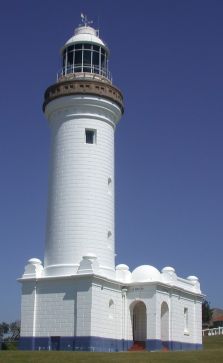|
|
|
|
‘ONCE A DANGER – NOW SAFE’ The Norah Head Lighthouse Story By Ian Roberts Like an old lady of the sea, Norah Head lighthouse has aged gracefully. Neither the harsh elements nor the passage of time appear to have taken a toll of the solid concrete blocks made from local sand and aggregate. The white tower and surrounding buildings have been maintained in a condition that belies their age, often reflecting the pink of dawn or shimmering with a coating of sea spray. Norah Head lighthouse started operating in November of 1903. This was 87 years after colonial architect, Francis Greenway, designed our first lighthouse on the southern entrance to Sydney harbour. |
 |
|
The Norah Head structure was broadly based on the architectural style used by Greenway, with some modifications. Edward Hargraves, who is credited with finding the first payable gold in Australia, is said to have played a role in the decision to construct the lighthouse. It’s believed that Hargraves, who lived nearby at Norahville, pressed the authorities to do something about the number of ships being wrecked in the area. The Lighthouses of Australia organisation says the cost of the 27 metre Norah Head tower and cottages was almost 19,000 pounds, while the light itself cost another 5,000. However, the reason for spending this considerable amount of money was spelt out clearly in the Latin words that were engraved above the entrance to the tower: "Once a danger, now safe." Originally, a vapourized kerosene burner and mantle generated the Norah Head beam. Remarkably, the lens floated in a bath of mercury to ease friction and the light was turned mechanically using a system of weights, not unlike a ‘grandfather’ clock. A report in the Newcastle Morning Herald in 1955 – more than 50 years after the lighthouse started operating – described the mercury as "worth more than one pound an ounce, or more than 15,000 pounds in all." The report also explained how the system of weights operated: "Weights are suspended nearly 100ft down a central column in the tower itself. These go down gradually as the light turns. The man on duty sets to every half an hour and winds these up to keep the life saving lamp turning". Reports from the time show that the first Light keeper was N. H. Williams, assisted by with N Hanson and S. Kells. Norah Head light emitted 438,000 candlepower and in clear weather, it could be seen 18 nautical miles out to sea. In 1923, the Norah Head light was upgraded to a Ford-Schmidt kerosene burner that increased its brilliance to 700,000 candlepower. Initially, the light revolved every 10 seconds, however, an early report on its operation said the speed of the light proved to be a headache for its keepers. ‘When they enter to adjust the burner or pump up the vaporisers, the keepers revolve with the light at great speed, which is a severe strain even upon those accustomed to it". Lighthouse records show that changes were made in 1928, when the light was slowed to revolve every 30 seconds. Then, in 1961, the lighthouse underwent a big change when the kerosene burner was removed in favour of mains electricity. The original crystal lens was retained, but the power of the light was increased to 1,000,000 candlepower. In 1995, the Norah Head lighthouse became full automated and today’s beam of light is provided by a 1000 Watt, 120 Volt tungsten halogen lamp, which flashes every 15 seconds and can be seen 26 nautical miles, or 40 kilometres, to sea. This centenary offers an ideal opportunity to applaud the role of Norah Head lighthouse in guarding over a highly significant section of Australia’s coastline. It was about 13 kilometres off Norah Head that Dutch-built vessel, the Nimbin, struck a mine and sank during World War II. Seven crew members were lost in that incident, on 5 December 1940. Almost two years later, on 3 June 1942, a BHP vessel, the Iron Chieftain, sank after a Japanese submarine torpedoed it. The vessel’s Master and Chief Engineer were among the 13 crew lost. The H M A S Bingara picked up twelve survivors from a raft north east of Sydney the following day. An additional 25 survivors in the ship’s lifeboat landed on North Entrance beach at about 6.00am on the June 5. The lifeboat was under the command of Second Officer J Brady, who had held it out to sea the previous night because he knew of the close inshore reef and was afraid of running foul of it in the dark. The submarine was believed to be part of the pack that destroyed shipping in Sydney harbour and shelled Newcastle. During the attack on Newcastle, the big guns of Fort Scratchley, defending the city, returned fire. The centenary of Norah Head lighthouse will be officially celebrated on 15 November 2003. Planning has been underway for several months and a special centenary news section has been established on the Wyong Shire Council website http://www.wyong.nsw.gov.au. Events being considered include an Air Force flyover; an antique car rally; a street parade and school writing and art competitions. The centenary planning group has also put out a call for former Norah Head lighthouse keepers and their families who would like to be involved in the activities. |
|
|
Centenary of Norah
Head Lighthouse
|
|
15 November 2003 Former keepers and families Anyone else who wishes to be involved For more information Peter Morris
|
Article and photograph courtesy of Ian Roberts, Wyong Shire Council.
![]()